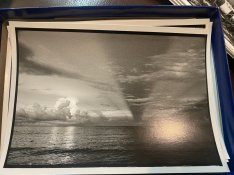I have sodium sulfate on hand. Longer or shorter dev times with addition of sodium sulfate?Xtol is as sharp or sharper than Rodinal. If you don’t want it as smooth as full strength Xtol you can try diluting it. Or use additives with Rodinal. Potassium thiocyanate at 1.5g/L per litre to working developer in Rodinal gives as fine grain as Xtol, so you may want to try half that or a quarter. It can speed up development with some films though.
Another option is sodium sulphite 20g/L would be a fair bit finer but not full Xtol level. You could make a stock solution in a jug, and pour some out and add your Rodinal when you want to develop.
-
Welcome to Photrio!Registration is fast and free. Join today to unlock search, see fewer ads, and access all forum features.Click here to sign up
You are using an out of date browser. It may not display this or other websites correctly.
You should upgrade or use an alternative browser.
You should upgrade or use an alternative browser.
Tri-X rodinal and skies ;-(
-
A
- Thread starter ericdan
- Start date
Recent Classifieds
-
For Sale Nikon FE (blk) w/ 35-70 f/2.8 (Read)
- Started by Acere
-
For Sale FS: Horseman Long Loupe 6X
- Started by B.S.Kumar
-
For Sale FS: Linhof Master GTL / AMS 4x5 Camera
- Started by B.S.Kumar
-
For Sale Four H&Y Magnetic 4" Filter Holders and Four Cokin B&W Contrast Filters
- Started by Steve Goldstein
-
Sold Schneider Kreuznach Super-Angulon 165mm - 8x10
- Started by Guivd
Forum statistics
Sodium Sulphite not sulphate, sulphate won’t do anything. With sulphite I would guess the times may trend towards a bit longer as it could buffer the pH to a bit lower than it normally is. You’d find out with a clip off a test roll if it needs more development or not.I have sodium sulfate on hand. Longer or shorter dev times with addition of sodium sulfate?
if you’re in Tokyo you can get Fuji Super Prodol for pretty cheap and use it diluted. If you already have Xtol you can use it diluted too.
Potassium thiocyanate at 1.5g/L per litre to working developer in Rodinal gives as fine grain as Xtol.
I wanted to ask you if your prescription is for 1:25 dilution but then I found the answer here.
Adding potassium thiocyanate to the working solution could yield fine grain but its not Rodinal anymore
Do you mean adding thiocyanate to Rodinal will also change tonality along with the grain?
Last edited:
baachitraka
Member
Adding potassium thiocyanate to the working solution could yield fine grain but its not Rodinal anymore 

However, unless someone who has used the same developer gives me the exact formula for a totally equivalent alternative after having experimentally ascertained the claimed equivalence, I'm not going to spend my time on it.
Raghu, yes... that would be for example the Xtol vs Mytol case, that is ascertained equivalent, or many other matching formulas in the FDCB.
... but anyway what I want to point is that we have two approaches:
1> I want that developer because it is fantastic and it does that...
2> I want to control what a developer does to adjust the result to what I want to craft
IMO the second way is a mind openning situation, we may get the same result in many ways. For example, the OP does not want the Rodi grain nor the Xtol grain... So IMO it is not important what Rodi or what Xtol does, the important thing is that we may add sulphite to Rodi or diluting Xtol. A bit it's the archer and not the arrow. Just a thought...
Still, there is nothing wrong in using a film-developer combination that yields what one wants, of course !
Xtol is as sharp or sharper than Rodinal.
...sharper, probably (but it depends on what we call sharp)
Last edited:
Xtol is as sharp or sharper than Rodinal. If you don’t want it as smooth as full strength Xtol you can try diluting it. Or use additives with Rodinal. Potassium thiocyanate at 1.5g/L per litre to working developer in Rodinal gives as fine grain as Xtol, so you may want to try half that or a quarter. It can speed up development with some films though.
Another option is sodium sulphite 20g/L would be a fair bit finer but not full Xtol level. You could make a stock solution in a jug, and pour some out and add your Rodinal when you want to develop.
That's pretty much an accurate summary of the situation - Rodinal simultaneously produces more visible granularity & is less sharp than Xtol because it isn't solvent enough to access the iodide in the emulsion, nor produce finer grain.
I can't imagine a worse combination than Tri-X and Rodinal, especially if we're talking about 35mm format. Xtol will give better results, as it is MUCH gentler on the high values than Rodinal.
Even 120 format Tri-X can be brutally harsh processed in Rodinal - I gave up the combination years ago. Here is an example - a 6X17 pinhole image taken on Tri-X and processed in Rodinal. Horrible, harsh tones and brutally ugly grain, especially in the lighter values:

Even 120 format Tri-X can be brutally harsh processed in Rodinal - I gave up the combination years ago. Here is an example - a 6X17 pinhole image taken on Tri-X and processed in Rodinal. Horrible, harsh tones and brutally ugly grain, especially in the lighter values:

The 'Rodinal gives terrible grain in highlights' opinion is almost always really just a case of poor quality/ cheap scanners with rubbish MTF performance not mixing well with Rodinal's characteristics.
Further to this, the 'Rodinal gives me way too much visible granularity in highlights' opinion is almost always from an excessive development time & overly optimistic shadow speed decisions. Especially in a 5x print. If you're doing a lot of burning in however, you will get more intensely visible granularity.
Further to this, the 'Rodinal gives me way too much visible granularity in highlights' opinion is almost always from an excessive development time & overly optimistic shadow speed decisions. Especially in a 5x print. If you're doing a lot of burning in however, you will get more intensely visible granularity.
Kamang!
D-76.
Yeah !
It can be said that D-76 is obsolete compared to Xtol, and perhaps this can be argued form the strict technical point of view because Xtol provides 1/3 stop advantage in the shadows with a finner grain, but D-76 has it's own particular beauty.
At the end TMY is technically superior to TX in many ways, but when Kodak was to discontinue it 3 or 4 decades ago promient artists assembled a riot, this is 2020 and TX is still sold. Anyway TX has been modified over time to be a less wilder stuff than it used.
Last edited:
Sodium Sulphite not sulphate, sulphate won’t do anything. With sulphite I would guess the times may trend towards a bit longer as it could buffer the pH to a bit lower than it normally is.
IMO, adding sulphite makes developer work faster in general, commanding shorter times. First the solvent action with the halide exposes more silver to the agents, not sure what will happen with pH depending on the developer. See this: https://www.photo.net/discuss/threads/adding-sodium-sulfite-to-developer.20742/
Also solvent action may increase a bit film speed, by exposing to the agents those electrical centers (that lost electron after some 3 photons) that can be under the crystal surface, so some "electrically marked" crystals that were not to start development do develop. This is my understanding, at least...
IMO, adding sulphite makes developer work faster in general, commanding shorter times.
It depends on the developing agent. See Table 1 of chapter "The Function of Developer Constituents" in Haist which lists the effect of sulfite on rate of development for several well-known developing agents. For para-aminophenol, sulfite addition increases the rate of development.
It depends on the developing agent. See Table 1 of chapter "The Function of Developer Constituents" in Haist which lists the effect of sulfite on rate of development for several well-known developing agents. For para-aminophenol, sulfite addition increases the rate of development.
Thanks for the info... I'll check it.
Think Lith developer. It has very little sulfite in it but is highly active due to the oxidation products of Hydroquinone, semi quinones, that are themselves very active. When more sulfite is added, it scavenges these oxidation products and the developer becomes less active.Thanks for the info... I'll check it.
Deleted member 88956
What dilution of Rodinal are you using? Sounds like standard 1:25, but it isn't stated.
Deleted member 88956
... Here is an example - a 6X17 pinhole image taken on Tri-X and processed in Rodinal. Horrible, harsh tones and brutally ugly grain, especially in the lighter values:
View attachment 256611
It is interesting what you see and what I see in that image. Just a proof not to take everyone's comments at face value. Subjectivity of supposed quality ought to be taken into account. Although I've no doubts many who've seen your post likely never even looked at the image just took the comment and ran away with it.
Overall, all I will say for this whole thread is: there are people in the analog world that appreciate Rodinal's quality, and there are those who for whatever reason will knock Rodinal no matter what the results are. For them there is no way to process anything in Rodinal and for every Rodinal use question there are always comments only suggesting to drop it. It's like instead of Rodinal being one of the most established universal developers ever devised, it is some sort of very task specific one that ought to be used with extreme caution.
In case it's not clear, I more then like Rodinal, not only for its generally very good to excellent quality, but near indefinite shelf life, the latter of which is no small determining factor. Perhaps all of it relates to my rather relatively low overall volume of film work, which still does not change how I vue Rodinal's results it gives me.
It is interesting what you see and what I see in that image.
Please explain: what DO you see in this image??
1:50What dilution of Rodinal are you using? Sounds like standard 1:25, but it isn't stated.
Bought xtol and developed one roll from that beach vacation in 1+2 dilution for 15mins. 5sec agitation every 30sec.
Definitely a different overall look and feel to the prints.
Pic of print to follow after work.
- Much easier to print negatives
- No. 3 filter on fomabrom in Neutol gave me results I like.
- MUCH less noticeable grain in the sky.
Definitely a different overall look and feel to the prints.
Pic of print to follow after work.
Deleted member 88956
We see this the same way. Different scenes make it a bit harde to compare, but overall look does appear quite close, and certainly as presented there are no dramatic differences.@ericdan What do you mean by "2 stops under" ?
I cannot spot any difference between the prints, looks pretty same to me..
I think some of the subconscious reactions to Rodinal come from reading comments on its performance before giving it a chance. Placebo approach would have likely taken Rodinal feelings in a different or at least more balanced direction.
I guess it’s not as obvious on these digital photos of the prints. Holding them in your hands you can really tell the difference. I’ve used rodinal like this for at least a hundred rolls. I usually don’t mind the grain. It’s just in open skies with little detail that you really see it. I guess this also shows that you can get decent prints even two stops underexposed and developed in rodinal.We see this the same way. Different scenes make it a bit harde to compare, but overall look does appear quite close, and certainly as presented there are no dramatic differences.
I think some of the subconscious reactions to Rodinal come from reading comments on its performance before giving it a chance. Placebo approach would have likely taken Rodinal feelings in a different or at least more balanced direction.
I mean the film is underexposed two stops. Sorry about that. The grain is really visible in the grey part of the sky on the first print above.
So you pushed Tri-X to 1600 with Rodinal? Isn't that a winner combo for maximizing the grain?
| Photrio.com contains affiliate links to products. We may receive a commission for purchases made through these links. To read our full affiliate disclosure statement please click Here. |
PHOTRIO PARTNERS EQUALLY FUNDING OUR COMMUNITY:  |




